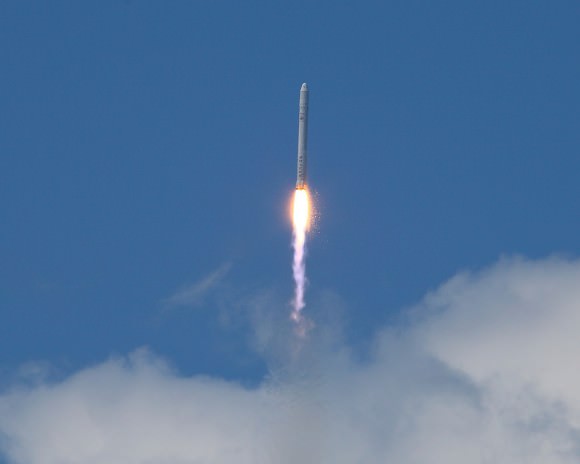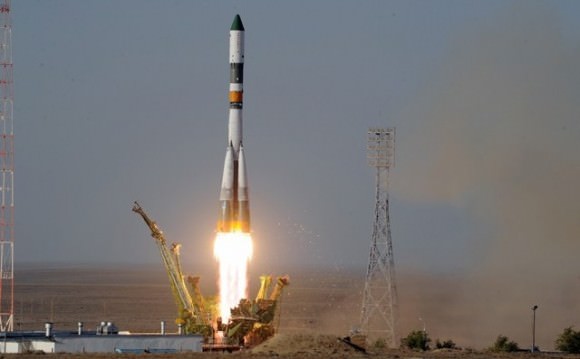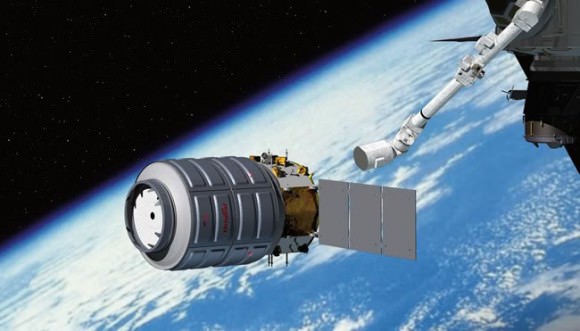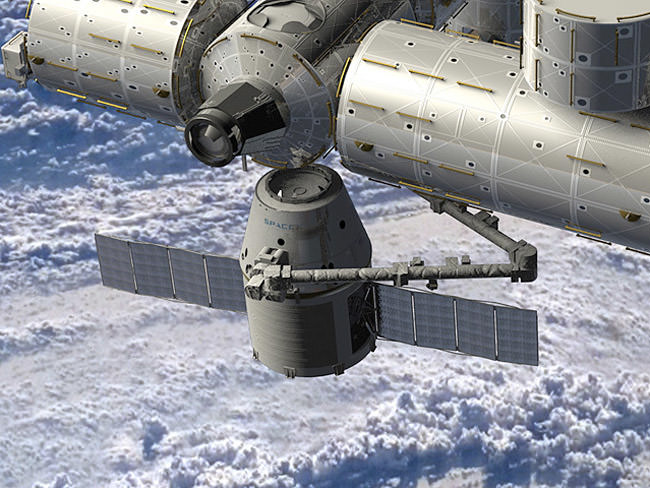[/caption]
It is looking less likely that Space Exploration Technologies (SpaceX) will be allowed to dock the next of its Dragon Spacecraft to the International Space Station (ISS). Instead it is now looking like the Dragon will be allowed to only come close the orbiting outpost to test out many of the spacecraft’s key systems.
This comes from a statement issued by Vladimir Solovyov, head of the Russian segment of the ISS mission control center on Friday and posted on the Russian news site RIA Novosti. Up until now SpaceX has stated that they would launch the next Dragon Spacecraft atop one of the company’s Falcon 9 rockets on Nov. 30. It is unknown now whether-or-not the proposed docking will be allowed to take place.

In a company-prepared statement, SpaceX stated that the company had been working to fulfill all of the necessary requirements to allow SpaceX to become the first private firm to dock its spacecraft with the ISS. Russia, however, has repeatedly stated that it will not allow this. The rationale behind this stance is based on safety. According to Russia, a vehicle, which has only flown once, does not have the established, proven track record required for such operations.
Moreover both NASA and SpaceX stated that while a final determination has yet to be made – the private space firm has not been denied the opportunity to dock with the International Space Station. Thus leaving the flight’s status in a sort of limbo. This situation also highlights that the assorted international members involved on ISS – don’t always agree.

Many industry experts noted the irony of these statements given that the last Soyuz rocket failed, causing the destruction of the Progress spacecraft as well as the three tons of supplies that the spacecraft carried.
NewSpace firms themselves have acknowledged anomalies in their programs – including SpaceX. Blue Origin recently lost one of its test vehicles. Apparently the rocket went off of its predicted flight path and range safety was forced to destroy the vehicle.

Under the initial Commercial Orbital Transportation Services (COTS) agreement SpaceX was supposed to launch the Demo 2 mission, which would have completed COTS Milestone 19 (the mission scheduled for this November) two years ago. Similarly, milestones 20-22 were scheduled to be accomplished by the first quarter of 2010.
COTS is a NASA-funded program, designed to coordinate delivery of both astronauts as well as cargo to the ISS by privately-owned companies. COTS – was announced in January of 2006, under the Bush Administration. As it stands currently, SpaceX is the frontrunner under this contract which also includes Orbital Sciences Corporation.


good article
Maybe it is just me, but the PlanetSpace/Lockheed Martin built Orbital Transfer Vehicle image in the last photo looks like R2D2 outside the Millennium Falcon.
Someone changed the picture!
Wasn’t the first ATV, Jules Verne, allowed to dock with the ISS on it’s inaugural mission?
http://en.wikipedia.org/wiki/Automated_Transfer_Vehicle#Jules_Verne
Hi Jon,
These are two totally different things. The vehicles mentioned (before, after and during edits) are from small, private firms. As Jeff mentions only the Dragon and Cygnus are still in the running.
The vehicle you mention, ESA’s ATV is produced by one of the ISS partner’s – Europe.
Sincerely, jason Rhian
Why are these two different things? The ATV did not have a proven track record, neither does Dragon. You’re saying because Dragon is made by a private firm it cannot be safe?
The Dragon is also made by one of the ISS partners — America. Like all of America’s share of the ISS, the actual construction is by a private company under contract to NASA.
Not to mention that Russia has repeated flown tourists to the ISS against the objections of the other partners. It certainly seems that Russia is witholding approval since they stand to gain financially as the only provider of transport to the ISS.
While the article mentions the statement by a Russian ISS official published by RIA Novosti, it does not mention the denial that NASA issued just a few hours later, stating that no decision has been made about whether SpaceX will be able to combine its C2 and C3 COTS flights (that is, approach and later berth with ISS) on a single mission. That puts into question the article’s claim that it is “looking less likely” SpaceX will not be allowed to combine the two flights.
Also, contrary to the closing paragraph of the article, ATK does not have a COTS award from NASA. Only SpaceX and Orbital Sciences have funded COTS agreements with NASA.
Hi Jeff,
The article has been fixed regarding your first concern. As Russia is one of the key partners on ISS – it’s likely that their concerns will be considered. It appears that NASA has pulled their tweet on this. Can you please provide some insight as to why?
ATK’s inclusion was an error – thanks for the correction.
Sincerely, Jason Rhian
Jason: NASA’s tweet hasn’t been “pulled”: the link to it in my original comment still works, at least for me.
When my editor tried to go to the tweet – she couldn’t.
@NASA NASA
Sorry, despite @ria_novosti reports, a decision has yet to be made regarding the upcoming @SpaceXer test flight to ISS. Incorrect story.
Works for me, if that helps.
The F9’s engines did not “fail” or shut down prematurely as other articles have reported. Rather, two engines exceeded preferred parameters; these parameters are designed to ensure that the engines can be re-used. Since the flight’s first stage was already not recoverable, and since at no time did the engines approach failure, they burned for the expected time.
The F9’s engines did not “fail” or shut down prematurely as other articles have reported. Rather, two engines exceeded preferred parameters; these parameters are designed to ensure that the engines can be re-used. Since the flight’s first stage was already not recoverable, and since at no time did the engines approach failure, they burned for the expected time.
Why can’t they just grab it with a robotic arm like Kounotori 2?
Read a little further, not in this article but in others. Both the Dragon and the Cygnus capsules are intended to work just like Kounotori, in that they are all to be grappled by the station arm and positioned for docking by the arm . . . not by the capsule thrusters. The ATV used its own thrusters and docking system, but they spent a month doing mock dockings before allowing it to really dock with the ISS. The HTV was grappled and docked on its first flight.
In fact, this need for grappling by the ISS was the reason there was some doubt about the November 30th launch date for SpaceX. There was (and still is) doubt as to whether anybody will be home to run the remote arm and grab the capsule, let alone empty the thing out once it’s docked.
Why don’t they try to dock the Dragon with an unmanned Soyuz spacecraft a couple of times to test its reliability and safety?
I still think Russia doesn’t like the idea that the U.S. will have another means to get to the ISS, and that Russia could miss out on a monopoly for ISS missions, which is why they are playing the “safety” card.
Ditto on that thought… Continuing with: One of Russia’s Progress vehicles crashed into the MIR space station. Are they being paranoid? or prudent?
Poor reporting – – Dragon doesn’t “dock.” It’s berthed with the robotic arm. Look at the first illustration in the article!
IIRC the first time the Shuttle docked with MIR, the Russians got cold feet and canceled the docking as the Shuttle was approaching MIR. The shuttle had to hold for a while before the docking could proceed.
I fully expect that the Russians will veto SpaceX from docking with the station, probably after the Dragon has been launched.
If the Russian’s have a Problem with SpaceX docking Sobeit, http://www.bigelowaerospace.com/ba330.php has a very viable Orbital and several together, well at least I get the Idea. Should they play there trump card so should we, called Private Enterprise and the COTs program. Any opinions on the ability of using this program to de-orbit and salvaging of lost Satellites. I trust there would be a lot of money to be made for recovery of sensitive and dangerous satellites. Also there are a lot of companies that would pay big monies to have Micro-gravity experiments that just don’t make it cause NASA did not want to, or, (I have a susperiment I do not want any other entity but myself to do. My eye’s only stuff). I see in my feeble imagination lots of ways to make it work, so “Lets Git’er Done”
This articles raise all my hackles, naturally. It was initiated by the idea that there was a change to the COTS approval strategy. But after that fell, there isn’t much more motivation than a review.
And it is a poor review. I will add to the dock vs berth and the ATV/HTV vs COTS approval (where COTS 2+3 equals the ATV/HTV dock respectively berth approval procedure, and does not insert more risk):
– The two image captions can well be switched:
“SpaceX’s next-to-next-to-last recent attempt to launch its unmanned Falcon-1 ended in the loss of the spacecraft as well as its cargo.”
“OKB-1 has had a string of successes – and failures – since its founding.”
– “NewSpace” is an umbrella term for an enthusiast movement, not a description of commercial spaceflight.
– The BlueOrigin New Shepard spacecraft is _not_ a part of COTS (or even CCDev2). If we should count every back yard NewSpace launch failure, they would count in the tens or hundreds each year!
– COTS delays are agreed with NASA. Which is good, since most delays, at least recent delays, seems to have been due to NASAs open ended (aka “moving target”) test protocol.
As contrast, NASA is still waiting on ULA, an official partner, to ready its CCDev1 EDS system that should have been finished 2010. ULA has repeatedly failed against agreement, latest in April (see above link).
I read somewhere that current official delivery plan is 2014, when ULA wants to launch a man rated Atlas IV.
Notable in this context is that ULA didn’t get any CCDev2 work, while SpaceX did. Apparently NASA and SpaceX _do_ agree!
Finally, I don’t understand the idea that an engine (or two) failed on the second Falcon-9 launch, the COTS-1 demo? The launch exceeded its target height, which indicates no loss of thrust I think.
However, that launch was plagued by aborted static firing tests that damaged at least one engine before launch. It was modified and used successfully.
Also, SpaceX has repeatedly failed to recover their used stages, which is adamant for their low cost reuse approach.
=======================================================
I have never heard Elon state that if they fail to recover used stages and reuse them they are going to have to raise their prices. It was more of an issue there wasn’t going to be the drastic lowering of costs to access space unless they figure out how to recover and reuse the used stages. I never got the impression that their current prices were dependent or recovering the stages.
I believe their lower costs are primarily due to building most of the components/sub systems in-house rather then buying existing systems with hefty mark ups.